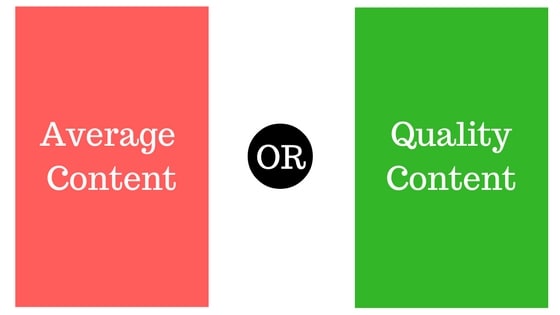Measure If Content is Quality Content
Content, content. Everyone tells you to produce great content and that Content is King. But how do you really know that what you’re writing — or having your staff or freelancers write — is actually quality content? You can’t simply conclude that if it’s producing engagement it’s good content, because as we know from the fake news epidemic on social media, click-bait can generate clicks and still be without worth. Not only that, but really good content can produce low engagement too, depending on theme and topic.

In this article, I thought it’d be a good time to stop and help you assess your content, to offer up some guidelines for producing great quality content, and offer some advice for testing yours to see if it can be improved.
If you’re more interested in reading about writing posts that rank better in search engines. Try this article about SEO.
Is your content interesting to your audience?
The first step is to simply ask the question: is what you’re publishing interesting? If you don’t want to read it and the rest of your team glosses over it as dull, boring or too thin, then you have a problem. While it’s important to publish content that helps drive visitors, it’s likely that sometimes you just won’t be able to get a certain topic to resonate with your audience. Here’s how to come out on top… most of the time.

Writing about what’s interesting to your potential customer can help keep you on the straight and narrow. Don’t leave out facts, cover your topic from head to toe. Think about what your audience was hoping to read when they clicked to read the article.
Think about this as well, if you’re writing a topic about something that has already been covered by someone else online, what will make your content better? Will your include more details, more images, videos? What makes your content stand out above the rest.
As they say, the cream rises to the top.
Interested in finding things to write about? Try some of these content tools out.
Quality content is well written
Another consideration to consider is the quality of the writing. Just as everyone who picks up a paintbrush isn’t going to produce a masterpiece, not everyone with access to WordPress or MS Word is going to be able to write something terrific. Readers want well-written content, however, and with the rise of freelance writers for whom English isn’t their native tongue, we all encounter lots of baffling and awkward prose online.
Don’t be that site.

If you do use freelance writers, make sure they’re good writers and that they are delivering prose that’s ready to publish, without spelling and grammatical errors. Ask an English major at the local college to proofread if you need confirmation, or use an online readability testing tool to assess whether it’s well structured and coherent.
If you’re paying for content and have a goal of publishing an article every day or similar, take a moment to assess: fewer, better quality articles could potentially benefit your site better in the long run than a never-ending stream of junk content that’s there just to trick the search engines.
Google suggests that you aim for a middle school reading level for your online content. This article is at a 9th-grade level, same as the BBC News website, for comparison purposes.
Do others say you have quality content?
A third consideration when assessing your content is what kind of feedback you get from readers, if any? Ideally, social shares, links, and comments should all affirm that the piece is interesting, provocative and insightful. You can also assess this yourself by simply asking whether it has those characteristics: is it interesting? Is it provocative? Is it insightful?

Analytics are your friend too: push traffic to your site and use analytics to identify which articles people read and which they spend the most time reading (see above). If you’re routinely publishing 750-word articles and the average time on page is 16 seconds, it’s a clear sign that visitors decide based on the headline, an illustration, or the opening paragraph that it’s not good content and they leave.
You can also send out a survey to a subset of your audience as a way to evaluate the value of your publishing efforts. If they don’t enjoy reading your content, if they don’t know you even have a site where you publish articles, then you might want to reconsider your strategy!
My final advice
Publishing online can be a lot like rowing a boat in the middle of a lake. You know you have to work at it and that a single stroke isn’t going to move the boat forward. You keep releasing new material, but are you heading in the right direction? Are you even moving in a straight line? The boat that moves more slowly but knows exactly where it’s heading is going to get there a lot faster than the boat that’s rowing in furious circles!


